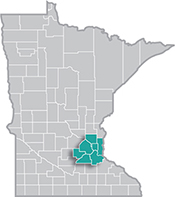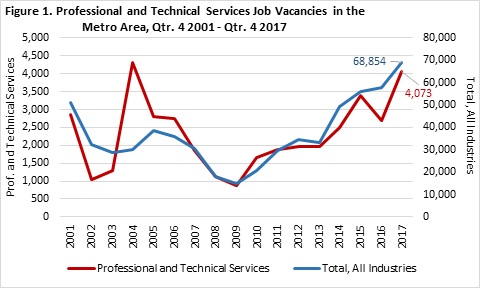 The Minneapolis-St. Paul metropolitan area is a national leader in finance, advanced manufacturing, agriculture and retailing.
The Minneapolis-St. Paul metropolitan area is a national leader in finance, advanced manufacturing, agriculture and retailing.
Medical devices, electronics and processed foods are strong suits recognized globally.
Want the freshest data delivered by email? Subscribe to our regional newsletters.
9/11/2018 12:00:00 PM
Tim O'Neill
Minnesota Economic Trends recently highlighted the importance of Professional, Scientific, and Technical Services in the Twin Cities Metro Area. Here’s the article, summarized:
One major set of data Trends did not analyze in-depth was job vacancies. This data set provides insight on current demand for Professional, Scientific, and Technical Services jobs as directly reported by employers (Figure 1).
As of the fourth quarter, 2017, Professional and Technical Services employers in the Metro Area reported over 4,000 job vacancies. For one fun fact, these 4,073 vacancies represented about 82 percent of the state’s Professional and Technical Services vacancies. For reference, the Metro Area accounted for about 61 percent of the state’s total job vacancies. So the demand for these jobs are especially concentrated in the Metro Area.
For another fun fact, employers in the Metro Area reported 1,367 more Professional and Technical Services vacancies during the fourth quarter, 2017, than they did the previous year. This incredible 51 percent increase in the number of such vacancies was much higher than the increase in the total number of vacancies across all industries in the region during that time – a 19 percent increase overall. For one more fun fact, these 4,073 vacancies represent the second-most vacancies ever reported for Professional and Technical Services in the history of DEED’s Job Vacancy Survey, only falling behind the 4,326 such vacancies reported by employers in 2004 (Figure 1).

Professional and Technical Services jobs typically require more post-secondary education, and this is true for current vacancies. Of those 4,073 Professional and Technical vacancies reported in the Metro Area during the fourth quarter, 73 percent required post-secondary education, with 60 percent requiring a bachelor’s degree or more. For reference, just 33 percent of the total vacancies across all industries required post-secondary education. Along with higher education, Professional and Technical Services vacancies had higher wage offers. The median hourly wage offer for Professional and Technical Services vacancies was $27.13 – 81 percent higher than the median wage offer for the total of all vacancies, at $14.95.
Since the Trends article was published, new projections data has been released by DEED. While this data has yet to be released at the regional level, it still highlights the rapid (anticipated) growth within Professional, Scientific, and Technical Services. For example, where total state employment is projected to increase by 5.8 percent between 2016 and 2026; Professional, Scientific, and Technical Services employment is projected to increase by 13.9 percent. This is equivalent to about 22,000 net new jobs over the next decade.
Stayed tuned for 2016-2026 Metro Area employment projections. And, if interested in looking for a job in Professional, Scientific, and Technical Services, check out DEED’s Career and Educational Explorer.
Contact Tim O’Neill at 651-259-7401.